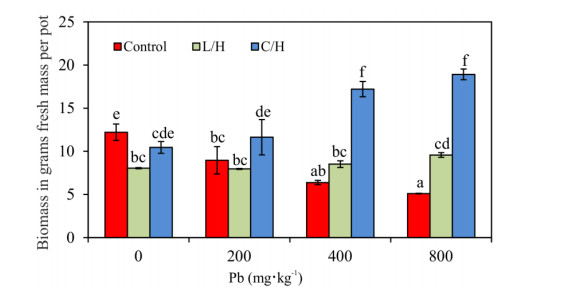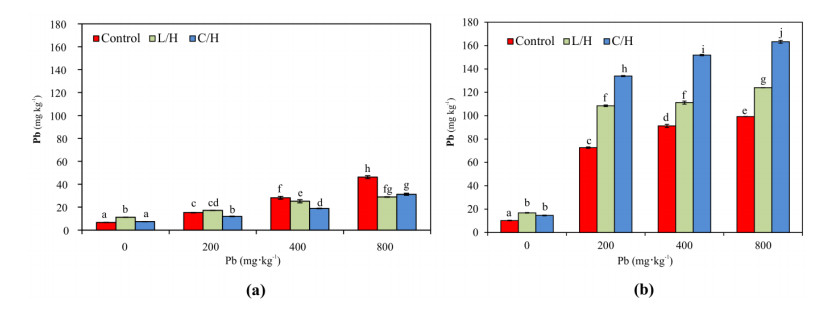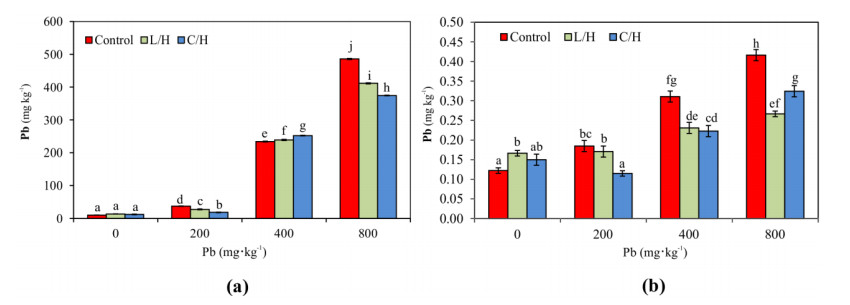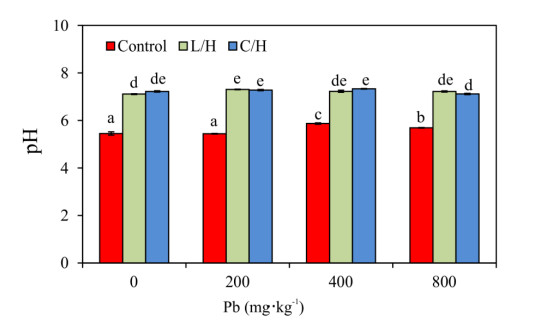Pressures exerted on the soil ecosystem due to its exposure to lead have a significant and aggravating effect on the quality of life. This study was conducted to investigate the aided phytostabilization of Pb-contaminated soils by novel combined amendments. The pot experiment was run under greenhouse conditions, using the following mixtures of immobilizing amendments: halloysite and limestone as well as halloysite and compost. The Pb contents in plants, both total and CaCl2-extractable Pb concentration in soil, were determined using the spectrophotometric method. The use of halloysite and compost was shown to be the most effective and decreased the average Pb content in the above-ground parts of F. rubra and in the soil and was found to significantly increase soil pH and Pb content in roots of the test plant. New methods should be developed to minimize the environmental risk posed by the presence of heavy metal pollutants. The results show significant effects of immobilizing amendments on the chemical characteristics of soil contaminated with Pb and the uptake of Pb by plants.
1.
Introduction
Human activities such as industry, agriculture and transport exert both indirect and direct effects on the soil chemical properties [1,2]. Progressive urbanization has severely disturbed the balance between the biochemical and geochemical cycles of many heavy metals. Considering their potentially detrimental nature and their long retention in the soil, it seems essential to determine the risk posed by heavy metals to human health and the natural environment. Since soil pollution with these metals is the main cause of soil degradation, the main goal of many soil remediation projects has been to decrease the environmental risk caused by different pollutants to a level safe for human health and ecosystems [3].
Pb is a ubiquitous element in the natural environment which is widely used in various industry branches [4]. It pervades the atmosphere, due to emissions from steel plants and cement plants [5,6]. Metal works, battery production plants, crystal glassworks and in the rubber, petroleum, and plastic industries as well as in the production of explosives and plant protection agents [1]. One of the sources of Pb in the soil is dry and wet deposition from the atmospheric air to which it migrates from combustion sources [7]. Pb has a high capacity for adsorption onto particles of atmospheric dust, hence-owing to dispersion-it is easily transported over long distances and its concentration is high even in non-anthropogenized areas [8]. Other significant sources of Pb in soils include ill-protected or illegal waste dumps. Leachates from these dumps infiltrate into the soil and contaminate it [9].
An appropriately designed phytoremediation method may lead to improvement in soil functionality by reducing the mobility of potentially toxic elements and affecting the biological processes proceeding in the soil [10]. The techniques of aided phytostabilization may prove successful, especially in problematic areas where soil is highly acidified and both sprouting and growth of plants are impaired [11]. There has been great interest recently in the search for cheap alternatives to traditional soil amendments to increase immobilization efficiency which do not require complicated and expensive pretreatments. Poland is among the countries abundant in naturally occurring minerals, i.e. limestone and halloysite. Due to their alkaline character, they have great potential to be used as mineral amendments in phytostabilization techniques. Moreover, composting is quite a popular method for waste management. Compost, due to its high content of stable organic matter and nutrients, can be used not only in agriculture as fertilizer, but also in soil remediation as an amendment to immobilize potentially toxic elements. Immobilization of potentially toxic elements accumulated in the soil using single materials, e.g., bentonite, compost, biochar, sewage sludge or ashes, has been addressed in scientific research, but information concerning the use of combined amendments is scarce [12,13,14].
F. rubra is a perennial lawn grass with a well-developed root system which is very resistant to drought. There is great interest in using F. rubra in phytoremediation due to its high metal tolerance and ability to accumulate different metals, especially copper, lead, manganese and zinc in soils affected by major industrial activities such as mining, energy and fuel production [15,16].
The study aimed at determining the effects of the application of combined amendments (mineral and mineral-organic) to the soil contaminated with Pb vegetated by F. rubra on Pb immobilization efficiency in the aided phytostabilization technique.
2.
Materials and methods
2.1. Characterization of soil and amendments
The soil used in the pot experiment was collected from the top layer (0–20 cm) from a non-contaminated site in an agricultural area (north-eastern Poland). The compost used in the experiment was prepared from 80% w/w of food waste and 20% w/w of wood pellets. The physical and chemical properties of the soil and compost are provided in Table 1. The compost had good fertilizing potential, due to its high contents of nitrogen, potassium and phosphate, and low content of Pb. The halloysite was purchased from Dunino strip mine (Poland), and limestone from “SILESIA” Sp. z o.o. (Poland). Table 2 presents selected properties of minerals amendments used in the experiment.
2.2. Experimental system
A pot experiment was conducted in the greenhouse of the University of Warmia and Mazury in Olsztyn, Poland. Soil/amendments mixtures were placed into polyethylene pots of 5 kg capacity and were maintained under natural day/night conditions. During the day (14 h), the air temperature was 26 ± 3 ℃, and at night (10 h) it was 16 ± 3 ℃, with a relative humidity of 75 ± 5%. F. rubra was selected for the experiment, because it is a suitable species for the re-vegetation of heavy metal-contaminated soils for their phytostabilization. Seeds (variety: Dark) were purchased from an authorized Seed Production Centre (Olsztyn, Poland). Soil contamination with Pb was simulated by the administration of the following doses (mg.kg-1 of soil) in the form of chemically-pure aqueous solutions of Pb(NO3)2: 0 (control), 200, 400, 800. The design comprised a total of 36 pots. At the beginning of the experiment, the plants were supplied with macro- and microelements using water solutions containing 26 mg of N, 26 mg of P, 21 mg of K, 12 mg of Mg, 0.5 mg of Fe, 0.25 mg of Mn, 0.25 mg of Cu, 0.2 mg of Mo, and 0.13 mg of B per 1 kg of soil. Two mixtures of soil amendments were used in the experiment: limestone with halloysite (L/H) and compost with halloysite (C/H). L/H and C/H were mixed with soil in proportions of 3% (v/v) and 1% (v/v), respectively. These amounts were considered optimal based on the results of a pilot study. Soils without Pb and amendments (0.0%) served as the control. The soil samples were thoroughly mixed and were allowed to stabilize under natural conditions for three weeks before being used in the growth experiment. The plants were watered every other day with demineralized water up to 60% of the maximum water holding capacity of the soil. The plants were harvested after 45 days and the soil was then collected. Plants were separated into shoots and roots. The rhizosphere soil tightly adhering to the roots was collected by brushing it off, after which it was air-dried and sifted through 2 mm sieves to determine the Pb content.
2.3. Chemical analysis of soils and compost
Upon completion of the first part of the experiment, the sieved samples of soil were stored at 4 ℃ prior to the analysis of their physicochemical properties. The pH value (1:5 H2O) was then measured in the samples of soil and compost using a Handylab pH/LF 12 conductometer (Schott, Germany). A modified version of the EPA 3051A method was used in the digestion process of soils. Briefly, 1.0 g of soil was weighed into a vessel, to which 9 mL of nitric acid (HNO3 p.a. with a concentration of 1.40 g.cm-1) and 1 mL of 30% H2O2 were added. The digestions were carried out in a Milestone microwave oven (Start D, Italy). All potentially toxic elements were analyzed with an ICE-3000 spectrophotometer (Thermo Scientific, USA). The content of CaCl2-extractable Pb was determined by extracting soil samples with 0.01 mol.L-1 CaCl2 at a 1:5 ratio and then shaking them at room temperature (25 ℃) for 2 h. A certified soil reference material (Sigma Aldrich Chemie GmbH, No. BCR142R) was used to ensure the accuracy of the analytical data. Total nitrogen (TN) content was determined with the Kjeldahl method [17]. Organic carbon content was determined with the Tiurin method after hot digestion of soil samples with K2Cr2O7 and H2SO4 in the presence of Ag2SO4 as a catalyst and the titration of K2Cr2O7 excess with FeSO4/(NH4)2SO4.6H2O [18]. In turn, phosphorus and potassium contents were assayed with the Egner-Riehm method [19] and magnesium content was assayed with the atomic absorption spectrometry method following extraction using the Schachtschabel method [20]. All chemical solutions were prepared using ultra-pure water (Millipore System, USA) of 0.055 µS.cm-1 resistivity and all chemicals used in this study were proanalytical grade.
2.4. Plant tissue analysis
After 45 days, the above-ground parts (shoots) and underground parts (roots) of F. rubra were uprooted and placed into paper bags. The roots and shoots were oven-dried at 55 ℃ to a stable weight and the dry biomass was recorded. The plants were then powdered using an analytical mill (Retsch type ZM300, Hann, Germany). A representative subsample was mineralized in nitric acid with 30% H2O2 using a microwave oven (Milestone Start D, Italy). Extracts were analyzed for total Pb contents by the Atomic Absorption Spectrometry (AAS) method using an iCE-3000 spectrophotometer (Thermo Scientific, USA). Triplicate analyses were performed for each sample.
2.5. Data processing and statistical analysis
The bioconcentration factor (BCF) was calculated by dividing the content of Pb in F. rubra roots by its corresponding content in the soil [21]. The translocation factor (TF) was calculated as the ratio of shoot-to-root contents of Pb [21]. Statistical analysis of the data was carried out with STATISTICA 13.3 software. The normality of distribution of traits within each independent group was checked with the Shapiro-Wilks test and verified with an analysis of the normality of residuals. A two-way analysis of variance-ANOVA (F test) was conducted using Pb dose and amendment type as factors. The Tukey test was used to determine the significant differences between mean values (at P < 0.05). The results of the post-hoc tests were expressed in the form of homogenous groups which were ascribed appropriate letters in figures.
3.
Results
3.1. Effect of soil contamination with Pb and the addition of combined amendments on F. rubra yield
The yield of F. rubra was significantly influenced by the dose of Pb and by amendment type (Figure 1). The wakes development of the plant was observed in the control soil (without the addition of combined amendments), which was especially tangible at higher doses of Pb. In the non-amended treatments, the increasing rates of Pb had an explicitly negative effect on the plant yield. Compared to the control soils, the highest F. rubra yield was obtained after soil amendment with a mixture of compost and halloysite (C/H) and its contamination with Pb doses of 400 and 800 mg.kg-1.
3.2. Pb content in F. rubra biomass
As shown in Figure 2, Pb accumulation was considerably higher in roots than in the shoots of F. rubra compared to the control variants, a significant decrease (by 28%) in the mean content of Pb in the above-grounds parts of F. rubra was determined after the combined use of compost and halloysite (C/H). In the roots of the test plant, the same mixture increased Pb content compared to the control soils. Pb applied in the doses of 400 and 800 mg.kg-1 of soil led to a nearly double increase in the content of Pb in shoots compared to the control.
3.3. Effect of the contaminating dose of Pb and the use of combined amendments on Pb content in the soil
The content of Pb in the soil was influenced by the contaminating dose of Pb as well as by the addition of combined amendments (L/H and C/H) to soil (Figure 3). The administration of compost and halloysite to the soil with the highest contaminating dose of Pb (800 mg.kg-1) led to a significant decrease in total Pb content in the soil, compared to the control soils. In the case of CaCl2-extractable form of Pb, all of the combined amendments decreased its content in the soil, with a greater decrease observed with the administration of compost and halloysite (C/H).
3.4. Soil pH
In the current study, the soil pH increased following the addition of the combined amendments (Figure 4). Compared to the control soils, the greatest increase in soil pH (1.26 pH units) was observed after the use of compost and halloysite (C/H). A similar, though slightly weaker, effect was noted for soil amendment with limestone and halloysite (L/H).
3.5. Pb accumulation and translocation in F. rubra
The mean values of the bioconcentration factor (BCF) determined for F. rubra reached 1.57 in the soil amended with limestone and halloysite (L/H) and 2.78 in the soil amended with compost and halloysite (C/H) (Figure 5). It should be emphasized that the value of this factor in the control soils (non-amended) was at < 1. In turn, the values of the translocation factor (TF) were the lowest for soil amended with compost and halloysite (C/H).
4.
Discussion
Areas which have been degraded or polluted with potentially toxic elements, including Pb, provide unfavorable conditions for the development of vegetation [22]. The proposed technique of aided phytostabilization will reduce the availability of heavy metals as well as produce the desired plant cover [23]. The incorporation of various amendments to soil has been proven to elicit a durable and positive effect on plant growth and development [24]. In addition, since a typical trait of polluted areas is the presence of metals in the form of mixtures and in high concentrations [25], the use of single amendments may fail to produce the expected effect of phytostabilization. Studies by Friesl et al. [26] have proven that the application of inorganic amendments to soil alleviates the toxic effect of heavy metals on soils and, at the same time, influences crop yield. The greatest average above-ground biomass was observed in cases of soil amendment with diatomite (45%) and chalcedonite (42%) as compared to soil without these amendments. Limestone also had a positive, but lesser influence [2]. Considering the above, the combined use of hallyosite with organic matter and limestone was proposed in this study. Current knowledge on the use of the proposed materials is sparse. The administration of limestone improved the ratio between Ca and Pb ions in the soil, by reducing Pb mobility and decreasing its uptake by plants. In addition, it effectively increased soil pH and, consequently, contributed to a reduction in the phytoavailability and excess accumulation of Pb [27]. In turn, the combined use of halloysite and organic matter contributed to reduced solubility of Pb ions, which was mainly due to a significant enrichment of the soil with organic matter and phosphates [28,29] and to soil pH increase, and this has ultimately led to a change in the mobility and bioavailability of Pb [30].
The current study demonstrated that the administration of organic matter (in the form of compost) to the soil had a positive effect on the effectiveness of Pb immobilization in the soil. The use of soil amendments of this type represents one of the basic techniques for the induction of xenobiotic biodegradation in the soil [2]. The direct addition of composts to the soil provides both nutrients and various microflora, which may lead to the effective immobilization of heavy metals accumulated in the soil which, in turn, may elicit a significant increase in the biological activity of soil [31]. This thesis has been confirmed in many studies, including these of Gondek et al. [32] and Adejumo et al. [31]. Those publications explicitly demonstrate that the administration of fertilizers based on organic waste, like e.g., compost or sewage sludge, contributes to the effective immobilization of heavy metals in the soil.
The negative impact of Pb on plants stems from its interactions with macromolecules, particularly proteins [33]. In addition, Pb affects the anatomy and morphology of plants and the major outcomes of its accumulation in plant tissues include plant growth inhibition caused by impaired mitotic divisions and debilitation of metabolic processes [34]. The bioconcentration factor (BCF) indicates a plant’s potential to accumulate elements and takes account of their initial concentration in the soil [1]. A higher value indicates a higher element content in plant biomass compared to its initial content in the soil. Plants suitable for the phytostabilization technique should be characterized by BCF > 1 and TF < 1 [35]. It is assumed that roots col-lect approx. 30–15% more lead than above-ground parts [36]. For this reason, F. rubra (used in the current study), together with the combined amendments, meets these requirements and seems suitable for use in areas contaminated with Pb. A similar effect was observed in earlier studies into the effect of mineral and organic amendments administered to soils contaminated with heavy metals [37]. Other studies also showed a similar tendency after soil amendment with a mixture of compost and halloysite [38]. They indicated a correlation between soil amendment with a mixture of halloysite and fish compost and the immobilization of nickel compounds in the soil [39].
Soil pH is a significant factor which determines the solubility of heavy metals in the soil [40] and affects, among others, assimilation of nutrients by plants and the course of physicochemical processes in soils [41]. A decrease in soil pH contributes to a reduced stability of bonds and to the damage of the microcrystalline structure of soil minerals, which results in soil sorption complex degradation and base cations leaching to the deeper strata of the soil profile. In the reported study, both of the combined amendments (halloysite/limestone; halloysite/compost) caused a significant increase in soil pH. To determine the availability of Pb to plants, it was first necessary to determine its total content in the soil and, secondly, to determine the contents of its bioavailable chemical fractions, including a form extractable in CaCl2
[42]. It should be emphasized that the reduction of contents of heavy metals occurring in this very chemical form is one of the main aims of the phytostabilization process [1]. The current study demonstrated that the administration of a mixture of halloysite and compost, as an immobilizing amendment used in experiments with soil contaminated with various Pb concentrations, caused the greatest reduction in the contents of both total and CaCl2-extractable forms of this element. To confirm the effectiveness of the proposed materials, it seems necessary to continue analyses of soil and determine the Pb contents in particular plant organs under in-situ conditions. Model studies, including these conducted under controlled conditions, represent a valuable source of information before transferring novel solutions to the in-situ conditions.
5.
Conclusions
The results achieved in the reported study provide a significant contribution into the development of safe technologies for land remediation and also indicate the feasibility of direct management of easily available amendments in the technique of aided phytostabilization. The proposed combination of halloysite with compost allowed modifying properties of the stabilizing material to an extent which enabled effective phytostabilization of soils contaminated with various concentrations of Pb. The study demonstrated a significantly higher accumulation of Pb in roots of F. rubra, a higher yield of the above-ground biomass, increased soil pH and decreased contents of the total form and mobile fraction of Pb in the soil after its amendment with a mixture of halloysite and compost, compared to the non-amended control soil.
Conflict of interest
All authors declare no conflicts of interest in this paper.






 DownLoad:
DownLoad:








